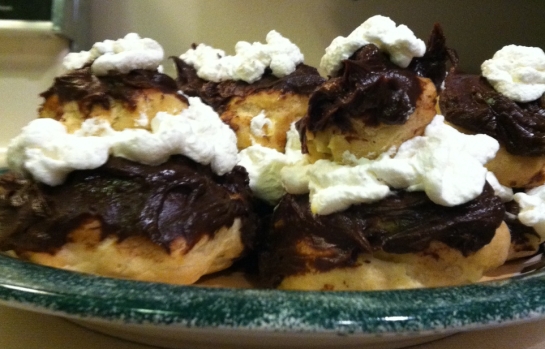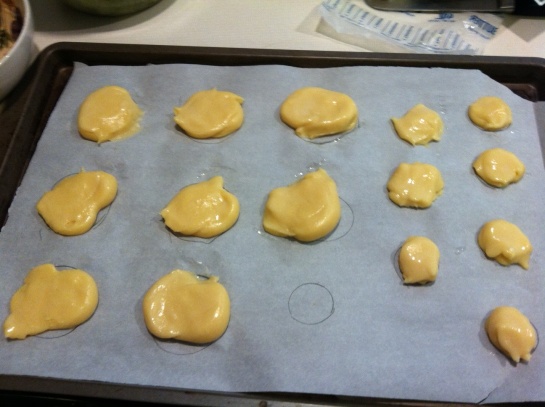Bonjour! C’est moi, le chat de tablier.
The first day of spring has arrived, and that can only mean one thing — it’s time to make another apron cake.
Today, I decided to tackle eclair et religieuse, which translates to a religious eclair. I could argue that most eclairs, if made well, are akin to a religious experience, but this one in particular is thought to have this name because when the little eclair is stacked onto the large eclair, dipped in chocolate, and dotted with whipped cream, it resembles a nun. That is, if we envision human body types the same way we do snowmen.
The first clue I had that this recipe was perhaps a bit more superFrench than the Opéra cake came when I typed “eclair et religieuse” into Google. All the results were in French. When Google offered to search for results in English, correctly deducing that my French skills stopped after the first paragraph of this blog, I found a few more results, including a film titled Un éclair, une religieuse, which I can only assume is about a nun who found an eclair behind the altar, a blog with a very pretty eclair et religieuse pictured, but no recipe, and finally this recipeon the BBC’s website from something called The Great British Bake Off. Works for me.
As an aside, you may wonder why I never copy recipes directly onto this blog (other than recipes I learned from a friend or just consider a basic part of my repertoire). The answer is that I worry it can be a copyright violation or a form of plagarism. If I were modifying or making these recipes my own in any way, that would be different, but I really just make them by following the directions 95% of the time. I do, however, always try to include links to the original so if you’re interested in joining me on my French pastry adventures, it’s easy enough to do so.
The BBC recipe had the advantage of being written in English with the not insignificant challenge of using metric measurements and British terms for ingredients. Here’s a quick primer:
- Apparently “corn flour” in British means cornstarch. I’m glad I looked that up before I dumped a pile of what I consider corn flour into my pastry cream.
- “Double cream” means heavy cream.
- “Caster sugar” is superfine sugar.
- I’m still not sure what the recipe meant by “plain chocolate,” but I used bittersweet chocolate and it worked out fine.
The other main challenge was translating from grams to cups. I know that many serious bakers use scales to weigh their ingredients, and I don’t fault them for it. That being said, it’s not a direction I want to go in my own baking. I absolutely appreciate the chemistry and science of baking, but I also feel like some of the art gets lost in the quest for ultra precision. I measure, but don’t weigh, everything that goes into a cake or a pastry, but you can’t calculate the grams of panache that I also throw in. (That may be the worst joke I’ve ever made.)
I knew we were short on flour, sugar, and butter, so I went to the store to buy the basics along with the chocolate and a few other small things I’d need for the pastry. I did this before I calculated how much 75g of flour or sugar is. Let’s just say, I didn’t need to buy the two extra bags of each.
Once I was home, though, I used a combination of random Googling, my calculator, and this amazing conversion table to go through the rest of the recipe and make the changes. For the record, 75g of flour is a mere 1/2 cup plus 2 tablespoons. (This got complicated.)
Since I already did the work, here are the conversions for the rest of the BBC recipe in case you want to play along at home. All of these are approximate (see the bit above about science versus art):
60g butter = 4 US tablespoons (to further complicate things, during my research I learned that apparently British tablespoons are different than American ones, but I’m not clear if (a) that’s true and (b) that’s only for butter).
75g flour = 1/2 cup plus 2 tablespoons
500mL of milk = 2 cups
75g of sugar = 1/3 cup plus 2 teaspoons
20g of cornstarch = 2 tablespoons plus 1 teaspoon
25g of flour = 2 tablespoons plus 2 teaspoons
150ml of heavy cream = 2/3 cup
The eggs translate 1:1, British to American. (That was a joke. A pretty good one, actually.)
So here we are, almost 800 words in, and we haven’t even gotten to the baking yet.
The eclair pastry starts with a choux dough, which sounds super exotic, but was actually incredibly easy to make. All you do is put butter and water on the stove together until the butter melts, then stir in the flour super fast and cook and stir for about 5 minutes. I loved the way this dough looked, so springy and grabable:
After that, it’s just a matter of adding a few eggs and piping it into 2″ and 1″ circles to bake into nun bottoms and nun heads.
I have a serious piping bag problem at the moment, which is that I’ve lost all my tips except for the thin narrow one (this guy), and I’m out of piping bags, so I’ve been cramming my one, often inappropriate tip, into the corners of Ziploc bags. This is a situation that could be easily remedied by buying a new set, but I haven’t gotten around to it. Hence the un-round nature of my pastries.
But oh my goodness, they looked great when they came out:
The recipe instructed me to draw those pencil circles on the parchment paper. I was a little upset to see that the graphite circles transferred onto the pastries themselves. But I figured that a little graphite never hurt anyone (I did not look this fact up to confirm, so please don’t put any stock in it) and pushed forward anyway.
The crème pâtissière isn’t what I think of as a pastry cream, but was more like a vanilla custard. At any rate, it seemed to take forever to make, but turned out nice and thick and rich.
The real problem was filling the choux pastries. My lack of an appropriate pastry bag and tip was a problem. The recipe helpfully suggested using a “jam syringe” as an alternative, but alas I have never heard of or owned such an implement. I ended up using a combination of my one sad tip, a Ziplock bag, a skewer, and my fingers to shove the filling inside, then tested to see if I had enough filling by picking up the pastry to see if it felt heavy-ish. It was a highly precise process that ended with my hands covered in crème pâtissière.
The eclair et religieuse as a whole consists of a little eclair filled with crème pâtissière and covered halfway with ganache stacked on top of a big eclair filled with crème pâtissière, and covered halfway with chocolate ganache. Then whipped cream is piped along between the two eclairs to make a “collar” and on top to make a “habit.”
This is what my little nuns looked like when they were all assembled:

I said there was an art to baking pastry, not that my creations look artistic when they’re finished.
My husband’s commentary on my interpretation of eclair et religieuse: “After my first bite, a good deal of it stayed on my nose, but I left it there to enjoy later.”
Like this post? Check out A Night at the Opéra, the first in the series of apron cakes. Honestly, it’s probably funnier than this one, but I’ll let you be the final judge of that.





